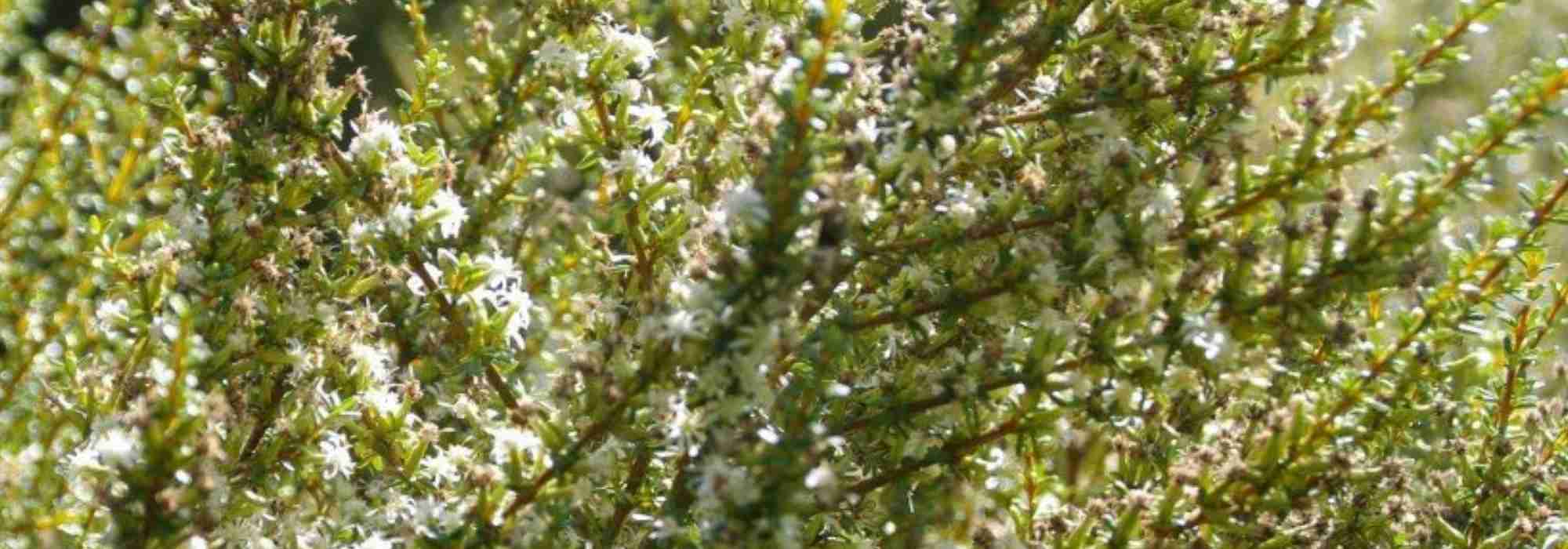
Olearia: planting, growing
Contents
Olearia in a nutshell
- Olearia are beautiful evergreen shrubs that withstand salty sea spray
- From spring to autumn, they produce star-shaped flowers resembling small daisies
- Hardy down to about -8°C, they are bushes suited to mild maritime climates
- Plant in full sun, in soil that is not too dry but well-drained
- They are valuable in windbreak hedges or as shrub borders in seaside gardens
A word from our expert
Olearia are beautiful shrubs highly valued for creating hedges or windbreaks in coastal gardens, sheltered from severe frosts. Their evergreen foliage, rapid growth, and dense shape allow them to form protective screens against the wind, standing firm against the spray.
In addition, in spring and summer, they are adorned with an abundant flowering of white, pink, purple, or blue reminiscent of asters.
While the most well-known is Olearia (x) haastii, also known as the “Tree Aster”, there are other species or varieties, all equally interesting, such as Olearia virgata with its fine rosemary-like foliage and Olearia solandri ‘Aurea’ with its yellow-bronze leaves. All are among the best evergreen bushes for creating effective windbreaks in coastal areas.
Hardy down to about -8 to -10°C, Olearia naturally fits into gardens along the oceanic or Mediterranean coasts. Relatively tolerant, they thrive in light, well-drained soil, but prefer it rather cool in summer.
Very floriferous, they are invaluable for creating a permanent display in mild climates. Discover our tips for growing them successfully!
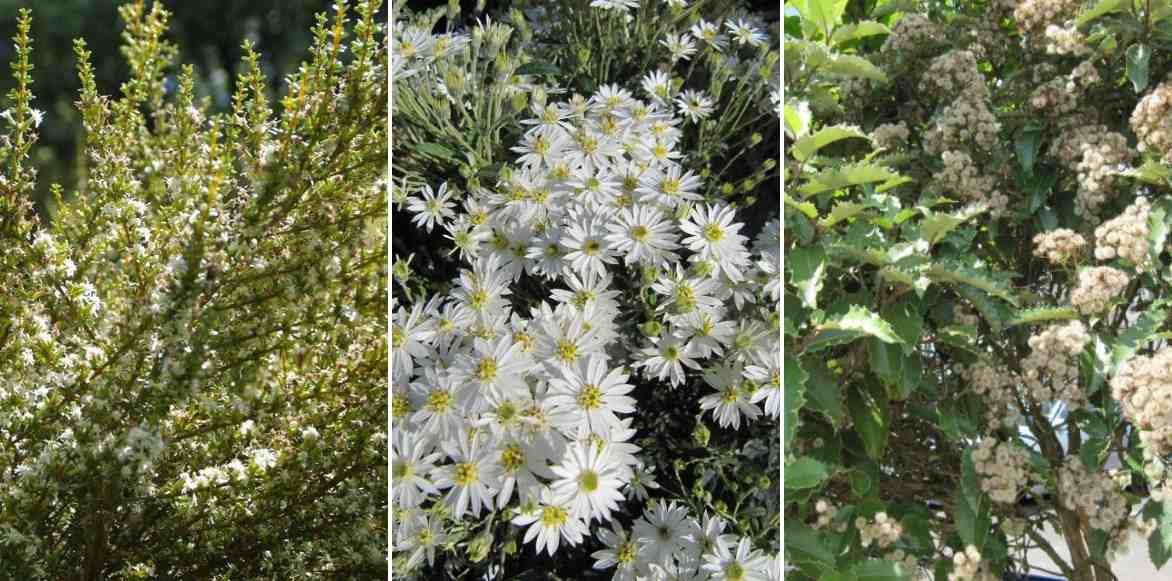
Olearia solandri ‘Aurea’, Olearia x scilloniensis, and Olearia macrodonta (© Leonora Enking)
Description and botany
Botanical data
- Latin name Olearia
- Family Asteraceae
- Common name Olearia, Tree aster, Daisy bush
- Flowering May-September depending on varieties
- Height 1 to 5 m
- Exposure Sun, partial shade
- Soil type well-drained, light
- Hardiness -8°C
Olearia is a shrub or small tree from the Asteraceae family, like asters and daisies, which gives some species the nickname “tree aster” or “daisy tree”.
The genus comprises around 130 species native to New Guinea, Australia, and New Zealand. In their natural state, they can be found in various habitats ranging from thickets or high-altitude bushes to forests, as well as peat bogs, coastal areas, and riverbanks. Among them, Olearia traversii, Olearia virgata, Olearia haastii, Olearia hybrid X scilloniensis, are evergreen bushes perfect for creating windbreak hedges, especially by the sea.
The silhouette varies depending on the species. Generally, Olearia forms a vigorous and dense bush that is more or less bushy, reaching an average height of 2.50m to 3.50m with a spread of 1 to 2 m, often growing rapidly. Olearia haastii and Olearia x scilloniensis form a beautiful, compact evergreen bush of 1.50 to 1.75 m in height all around, while Olearia traversii can reach 5 m in height with a spread of 3 m. Olearia solandri ‘Aurea’ stands out from other Olearia with its massive heather-like appearance.
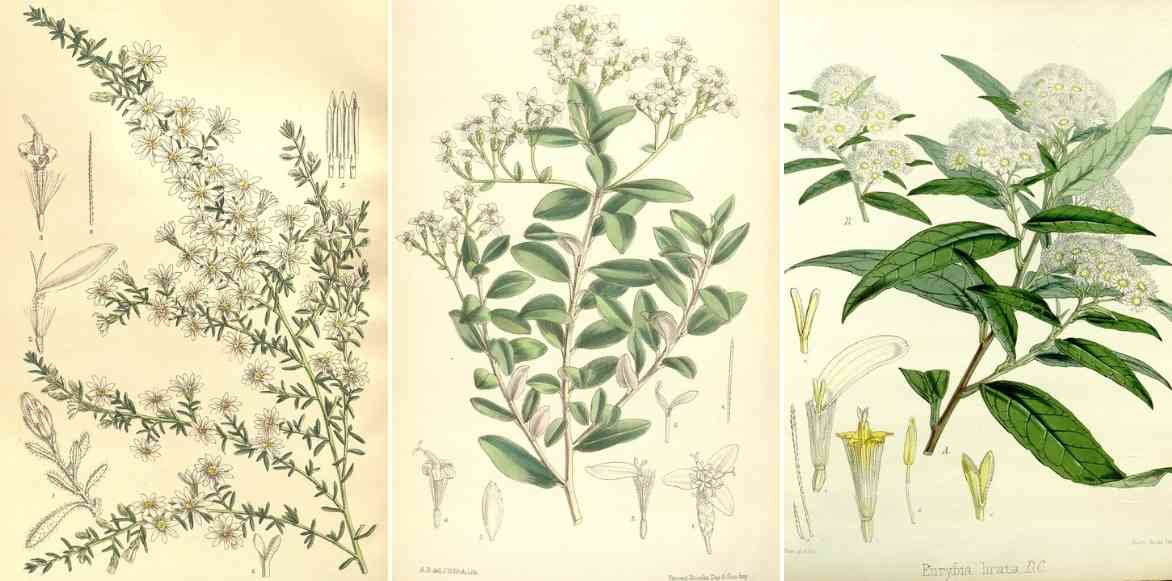 Olearia ramulosa, Olearia haastii, and Olearia lirata, Botanical plates, circa 1850
Olearia ramulosa, Olearia haastii, and Olearia lirata, Botanical plates, circa 1850
Its quadrangular, sometimes downy branches bear persistent and leathery foliage, which varies significantly from one species to another. This is the main attraction of the shrub. The leaves are simple, entire, oval to elliptical, alternate or rarely opposite, measuring 1 to 12 cm in length, sometimes wavy and dentate. They are green to grey-green on the upper side, with a white-silver or fawn tomentose underside.
While the foliage of some Olearia species resembles that of the olive (olea, meaning olive in Latin), Olearia virgata is distinguished, for example, by its very narrow linear leaves, which more closely resemble those of rosemary. They resemble holly in Olearia macrodonta, syn. Olearia x macrodonta or New Zealand holly. In this species, the foliage emits a subtle, slightly musky fragrance when crushed. The Olearia solandri ‘Aurea’ also differs from other species by its fine and highly branched growth, covered in tiny, very narrow leaves, resembling those of heather, in a golden bronze green.
From late spring to late summer depending on the regions, the vegetation is covered by a remarkably abundant flowering. This mass of flowers consists of a multitude of fragrant heads, often white, sometimes cream, yellow, blue, purple, or pale pink, depending on the varieties, ranging from 6 mm to 2 cm in diameter. Similar to small daisies with yellow or dark purple centres, they are solitary or grouped in corymbs or panicles 8 to 20 cm wide, well clear of the leaves. They exude a pleasant vanilla scent that is very attractive to pollinators like bees. The fertilised flowers produce fruits, the achenes topped with a plume: once mature, the centre releases tiny seeds dispersed by the wind.
“`
Read also
10 perfect bushes for a seaside gardenMain species and varieties
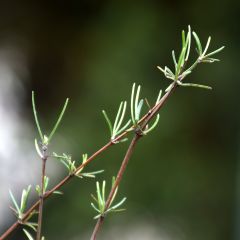
Olearia virgata - Daisy Bush
- Flowering time July to September
- Height at maturity 3 m
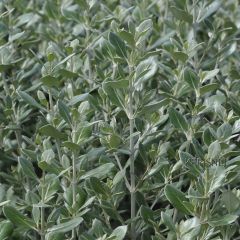
Olearia traversii - Daisy Bush
- Flowering time August, September
- Height at maturity 5 m
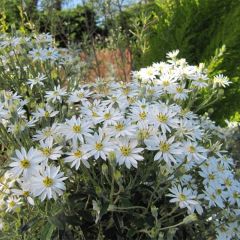
Olearia scilloniensis - Daisy Bush
- Flowering time June, July
- Height at maturity 1,50 m
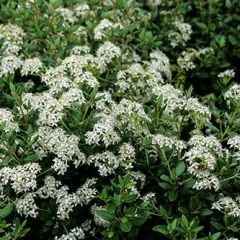
Olearia haastii - Daisy Bush
- Flowering time August to October
- Height at maturity 1,60 m
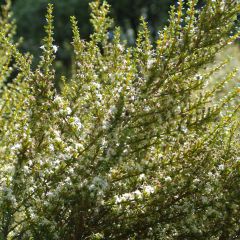
Olearia solandri Aurea
- Flowering time September, October
- Height at maturity 2 m
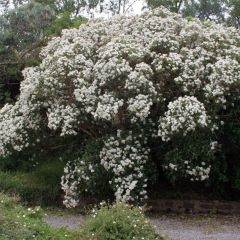
Olearia macrodonta Major
- Flowering time August, September
- Height at maturity 2 m
Discover other Olearia
View all →Available in 1 sizes
Available in 1 sizes
Available in 1 sizes
Available in 1 sizes
Available in 2 sizes
Available in 1 sizes
Available in 1 sizes
Available in 1 sizes
Available in 1 sizes
Available in 1 sizes
Planting Olearia
Where to plant it?
Rather not hardy and therefore sensitive to cold, Olearia can withstand frosts of around -8 to -10°C. Its cultivation in open ground should be reserved for regions where winters remain mild and where frost does not last too long. It is therefore interesting for creating a permanent display in a mild climate. It is a bush perfectly suited to the oceanic, or even Mediterranean, gardens of our country. Resistant to wind and salt spray, it naturally finds its place in a seaside garden as a windbreak bush. In more rigorous climates, in regions north of the Loire, it will need to be sheltered from cold, drying winds and it is preferable to plant it in a large pot to be stored for winter in an unheated greenhouse or conservatory.
It requires a very sunny position with at least 4 hours of sunlight minimum per day to thrive.
Olearia enjoys a light, well-drained, deep soil that remains slightly cool in summer, particularly in Mediterranean climates, although it tolerates summer drought fairly well, provided the soil is sufficiently cool. It appreciates sandy or humus-bearing soils and will thrive in many sheltered gardens with light, even slightly stony, soil. An ordinary well-draining soil will do perfectly. However, it does not like waterlogged soils in winter. Once well established, it can live for many years. Some, like Olearia virgata, tolerate drought and poor soils quite well.
It is a perfect bush for a free or evergreen hedge in a seaside garden, positioned centrally or in the background of a shrub bed, as well as in isolation.
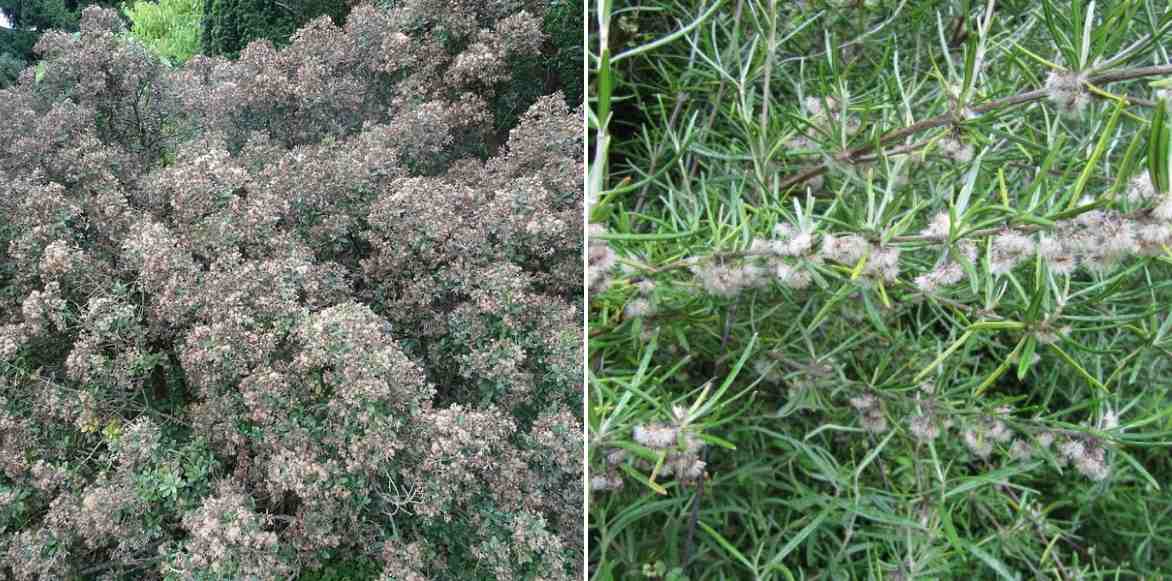
Olearia haastii (© Olive Titus) and Olearia lacunosa (© Leonora Enking)
When to plant?
The planting of an Olearia is preferably done in spring when all risk of frost has passed or in early autumn in very mild climates.
How to plant it?
In open ground
For hedge planting, maintain a planting distance of about 1 to 1.20 m between each plant.
- Dig a hole 3 to 5 times wider than the root ball
- Prepare a good layer of gravel at the bottom of the planting hole
- Plant the bush, ensuring the collar is level with the soil surface
- Fill in with a mixture of garden soil and potting soil
- You can add a bit of compost, especially if the soil is poor
- Firm the soil and water generously at planting
Pot culture
Plan to place it in a large pot of at least 50 cm in diameter as this bush has a large wind resistance. Good drainage is essential.
- Spread a good layer of gravel or clay balls at the bottom of the container
- Plant in a mixture of coarse sand and leaf compost
- Water generously
Read also
10 evergreen shrubs for coastal gardensMaintenance, pruning and care of olearia
In open ground
Olearia is easy to grow in regions with mild winters. It prefers soil that remains slightly cool in summer. Water regularly during the first year after planting to encourage establishment, especially during prolonged heat. Throughout the warm season, water moderately but consistently to keep the base cool, but not waterlogged.
Mulch the base of the bush in autumn to protect it from frost, especially during the first winters. In regions north of the Loire, protect the bush from severe frosts and snow that can scorch its leaves with fleece.
In pots
Water generously in summer, allowing the substrate to dry out slightly between waterings. To encourage growth, apply a little slow-release fertiliser at the end of winter and in autumn. Bring the pot indoors to protect it from frost in cold regions, placing it in an unheated room where the temperature does not drop below 7 °C. As soon as the risk of frost has passed, take it back outside to enjoy the beautiful season.
Pruning
Pruning helps stimulate flowering, densify the branches, and maintain a lovely bushy habit. Each year, after flowering, or in March-April, lightly cut back the stems to encourage the plant to branch out, while retaining the base of the wood from the previous year. This is necessary for potted specimens to keep them within reasonable proportions and maintain a compact habit.
Diseases and potential pests
When grown under good conditions, Olearia is relatively resistant to diseases and pests. However, it can fall victim to mealybugs, which are visible as cottony clusters left on the stems and undersides of the leaves. Treat with sprays of rapeseed oil. Repeat two or three times at 15-day intervals.
Propagation
Olearia propagates easily by cuttings. Sowing with the type species is also possible if you have harvested the seeds from the garden. This is done in a warm seed tray using a sandy substrate. Semi-woody cuttings taken at the end of summer are simpler and more reliable to carry out.
- At the end of summer, take new shoots from the year just below an eye, measuring 10 to 15 cm
- Remove all the leaves from the lower part of the stems, leaving only 2-3 leaves
- Incise the bark for 2 to 3 cm in length
- Insert them into a well-draining sandy substrate
- Place them under a frame
- Regularly moisten the cuttings
- Keep the young plants sheltered throughout the winter
- In the following spring, repot these cuttings into individual pots
- Keep them in pots for 2 years before planting them in the ground
Pairing ideas
With its bright foliage that dances beautifully with the wind and light, Olearia is a valuable plant for enlivening a garden throughout the year in a mild oceanic or Mediterranean climate.
In a flowering evergreen hedge in a mild climate, it will accompany other shrubs with summer or autumn flowering such as Escallonias, Eucalyptus gunnii ‘France Bleu Rengun’, Eleagnus ebbingei, and a Viburnum tinus ‘Eve Price’.
It can also be mixed with shrubs that have staggered flowering such as Ceanothus (Ceanothus impressus ‘Victoria’, ‘Italian Skies’, ‘Concha’, ‘Puget Blue’, ‘Skylark’…), and small Arbutus.
It easily pairs with other evergreen shrubs such as Leptospermum, Atriplex halimus, Anthyllis barba-jovis, Hippophae rhamnoides, Elaeagnus angustifolia ‘Caspica’, or even bushy wormwoods.
In windbreak hedges, it should be planted in front of a row of taller shrubs such as the coastal griselinia. Don’t hesitate to mix Olearias together, as they offer a beautiful diversity of sizes and will create effective and harmonious green screens.
In a large, colourful and elegant shrub mass, it will shine alongside Grevillea, Callistemon, and summer Tamarisk (Tamarix ramosissima). Accompany its base with curry plants and sea mallows.
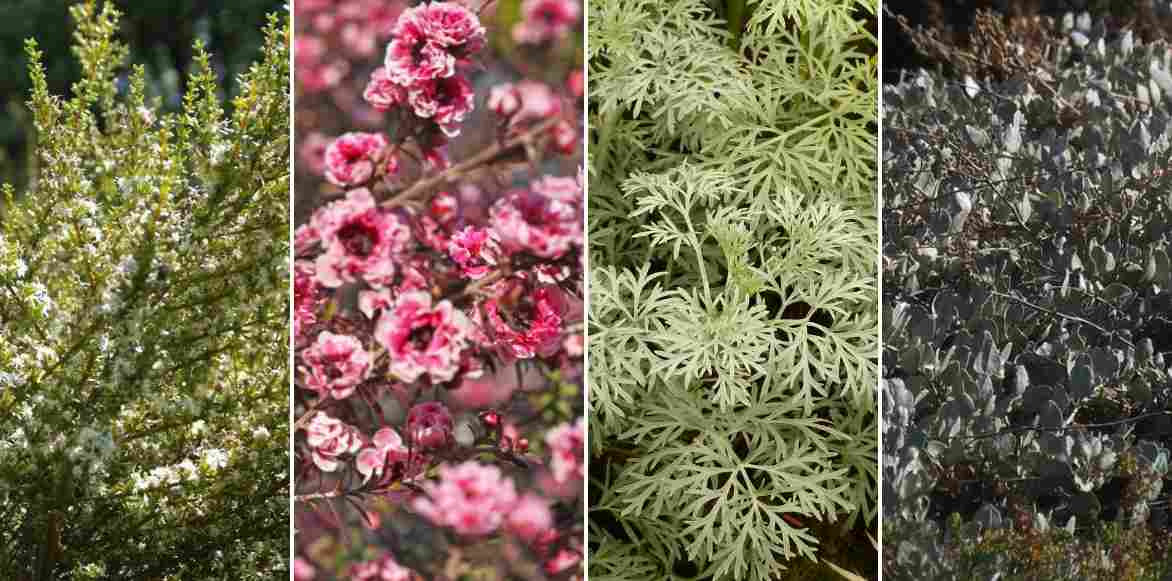
A seaside association: Olearia solandri ‘Aurea’, Leptospermum, ‘Powis Castle’ wormwood, and Atriplex halimus (© G. van Noord)
Useful resources
- The most beautiful shrub collection for oceanic and coastal climates is with us!
- Subscribe!
- Contents


































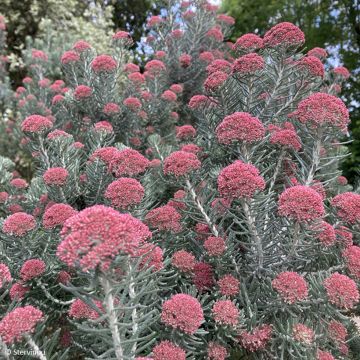
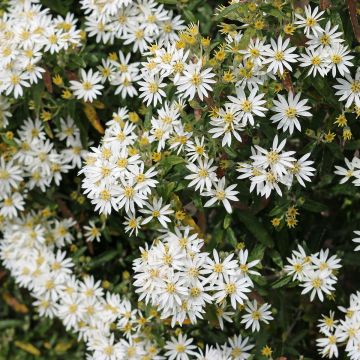
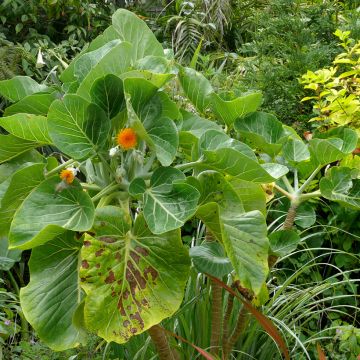
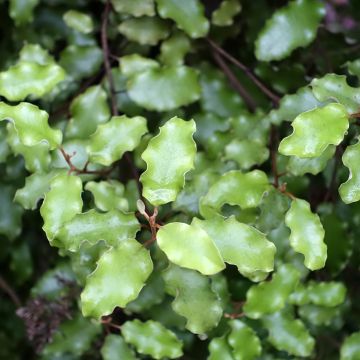



Comments